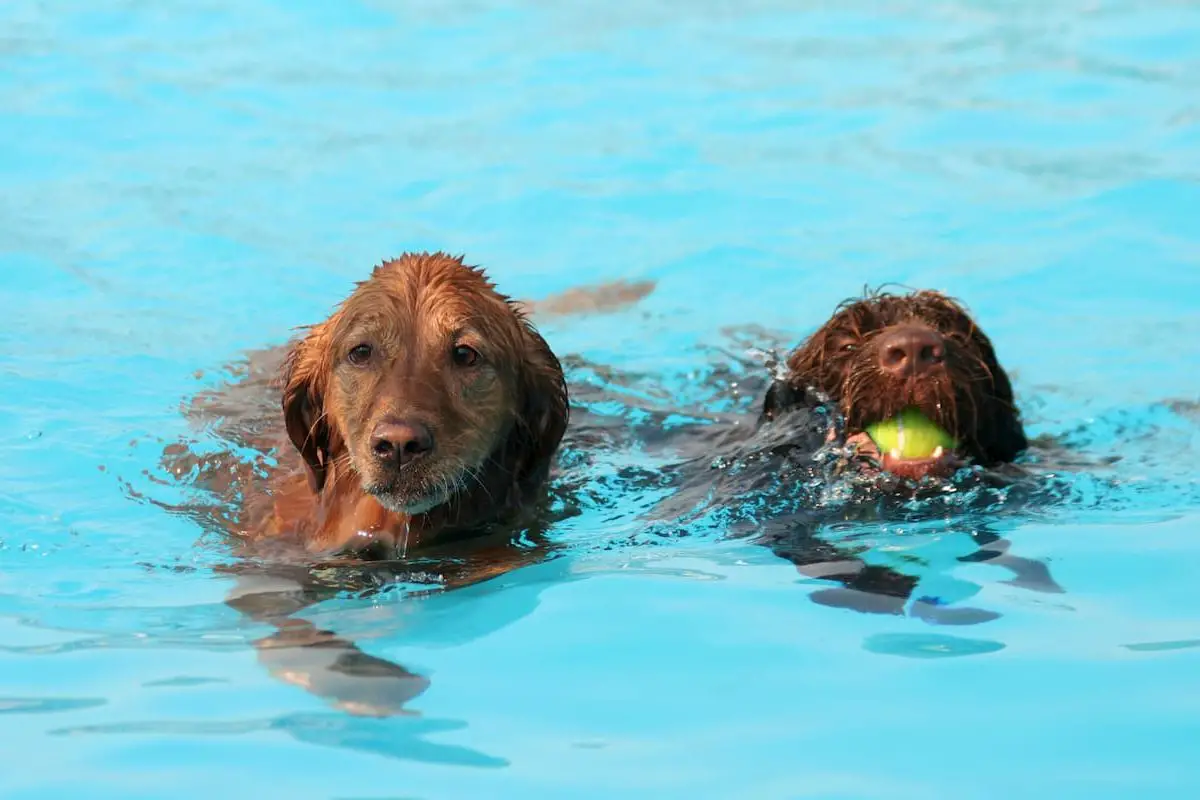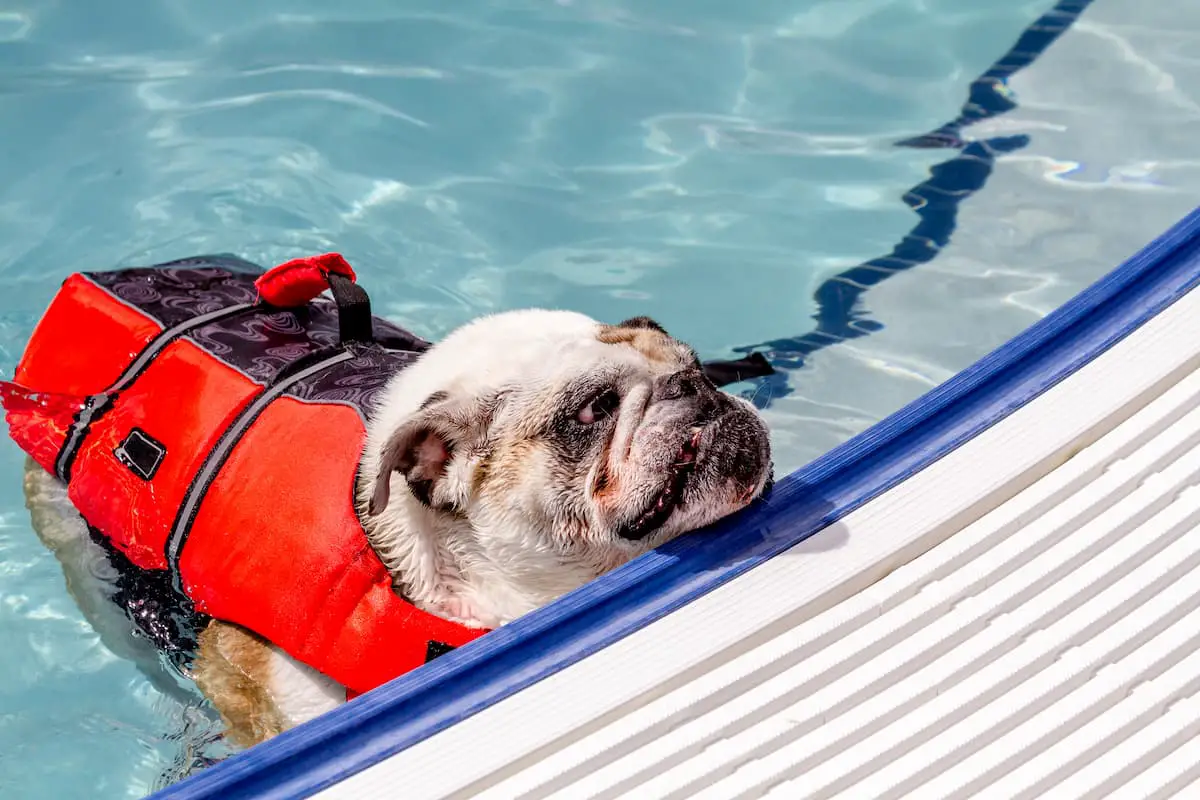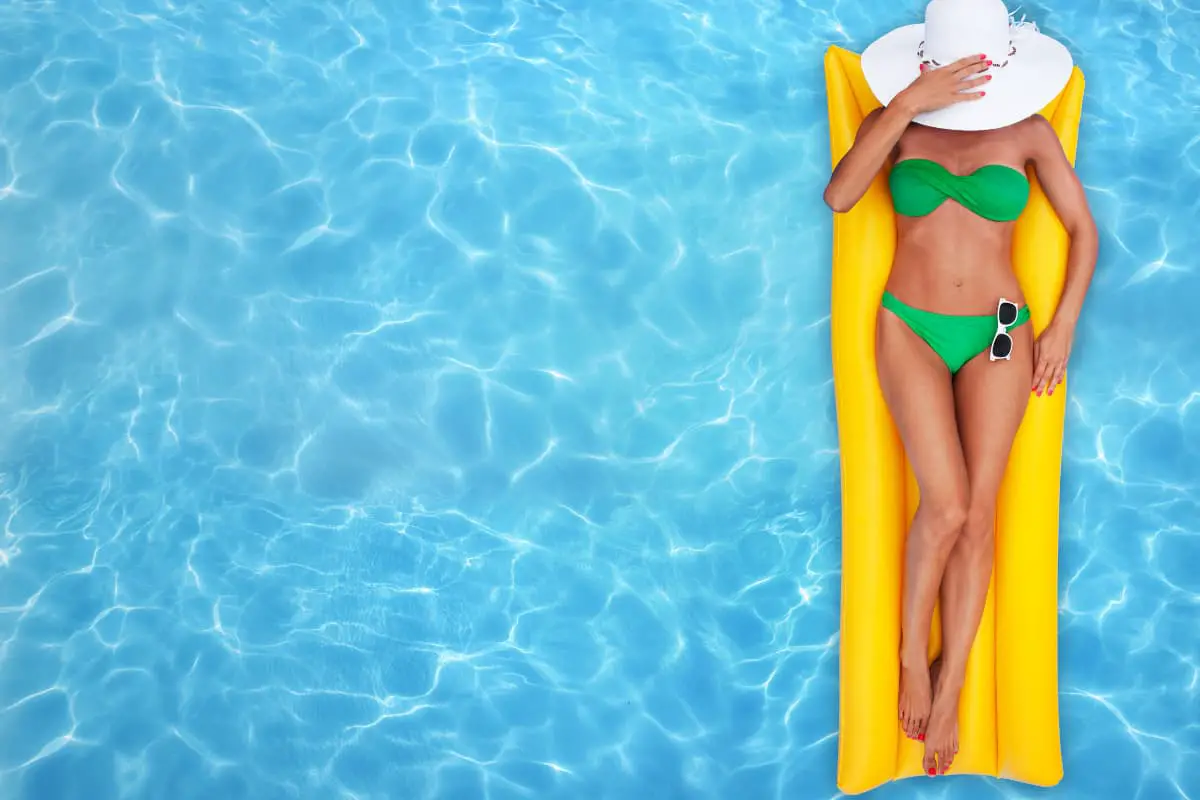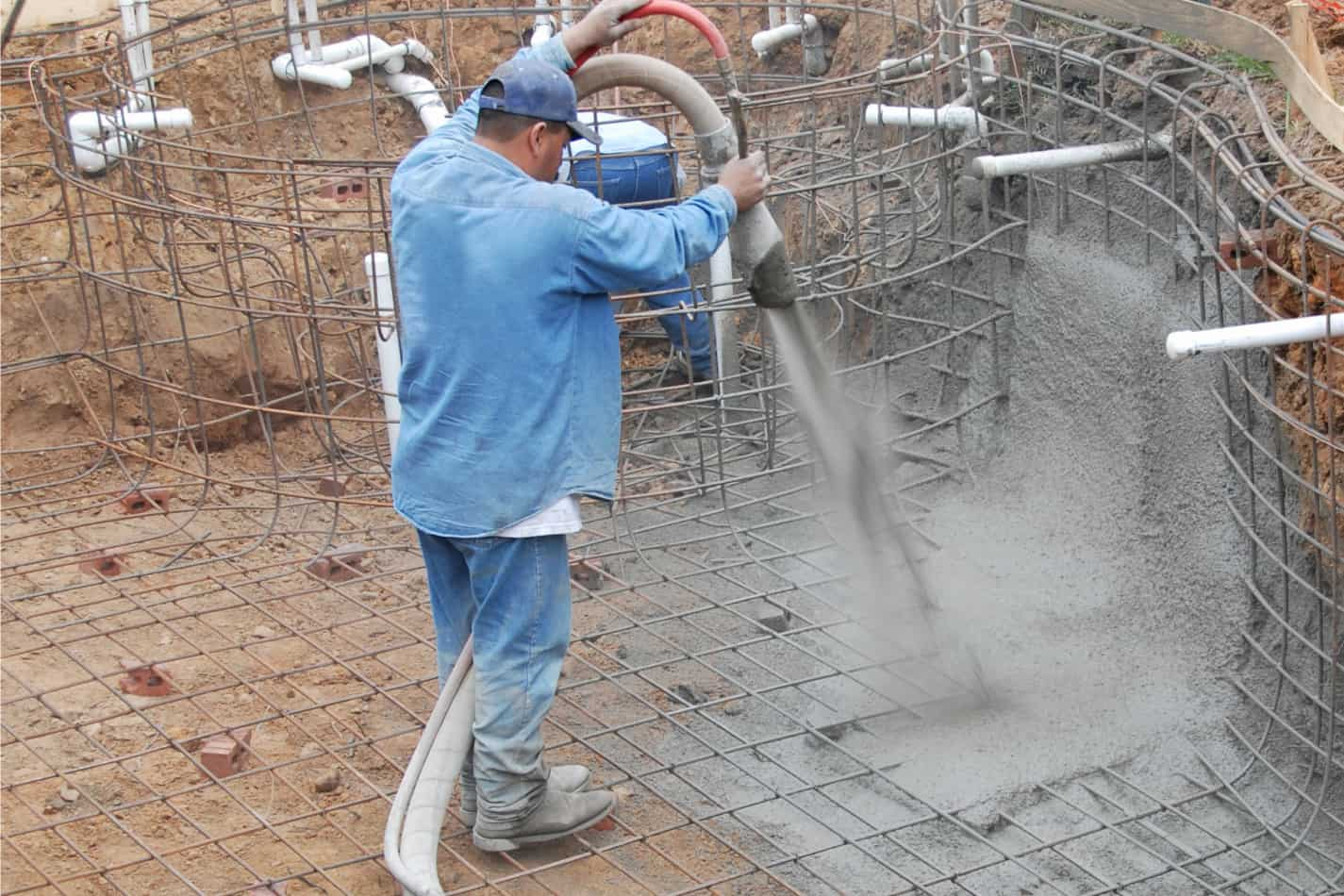Mans Best Friend and the Pool: Can Dogs Use Swimming Pools

As an Amazon Associate I earn from qualifying purchases.
Summer’s here, and you must be planning on enjoying a relaxing time in your pool. Naturally, you’d also want your dog to enjoy your pool as well. But you are probably wondering, can dogs use swimming pools? Is it even safe for dogs and can chlorine hurt a dog?
There is no reason why your dogs cant swim in swimming pools other than some breeds don’t possess innate skills, in fact, many breeds enjoy the activity and effort. Where you must focus for safety is on over chlorination and ingestion level overall. As long as chemicals are balanced, it is not typically harmful to dogs.
In this article, I will explain in great depth the ins and outs of dogs swimming in swimming pools. The dangers it possesses and what you can do about it.
After reading this article you will be equipped with all possible knowledge you might need for taking your buddy for a swim in your pool and ensuring his or her safety while doing it. So, without further ado, let’s begin.
Learn How to Manage Your Pool and Hot Tub
Frustrated trying to keep your pool clear? Feeling confused about when to add the right chemicals? Get the perfect easy-to-use, illustrated ebook and video course today!
Is Swimming in The Pool Safe for Dogs?
Swimming pools are quite safe for dogs as long as they know how to swim. If your dog is a natural swimmer or has learned to swim, he can certainly be secure in a swimming pool.
To ensure this safety, he should also be under supervision at all times. Never keep your dog unattended while he is inside the pool.
If your dog hasn’t learned how to swim, then gently and gradually teach him how to. Don’t just force your dog to get into the pool.
Let him explore the grounds and be comfortable enough to decide to get into it finally. Because forcing him may make him uncomfortable and panicky.
Another thing that people worry about is if the water is safe for their dogs. Well, as pool water contains chemicals, this concern is valid as chemicals can definitely harm your dog.
The thing about pool waters is, as long as it is monitored so that the level of chemicals is balanced, it is not a threat to your dog.
However, an imbalance in chemicals can cause harm and make your dog feel irritated.
So, to sum up, pool water is safe for dogs as long as the above-mentioned specifics are being maintained.
Can Pool Water Chlorine Hurt Dogs?
Chlorine is one of the most cost-effective ways of keeping a pool clean and safe. It keeps the pool clear from all sorts of microorganisms, such as algae, and bacteria
Therefore, without the use of chlorine in pool water, it becomes quite hard to maintain the safety and cleanliness of the pool.
Even though the amount of chlorine used in pools doesn’t usually harm human beings, can chlorine hurt a dog? Unfortunately, our furry friends can surely be harmed if the level of the chemicals used in the pool is not properly balanced.
Usually, in pools, the amount of chlorine and other chemicals are maintained at a specific level to make sure it is neither harmful for humans nor animals.
However, if the chemical balance is not maintained properly, there’s a high risk of toxic poisoning. This imbalance can cause your dog irritation to the airways, eyes, and skin.
The chlorine gas that’s released by an imbalanced chlorinated pool can also cause severe breathing problems for your dog.
An ear infection is another concern when it comes to your dog, swimming in pool water. Even though some people think the pool’s chlorinated water causes it, the fact is it is due to the excess moisture in the ears.
However, chlorine and other chemicals do play a certain part in this. So, making sure that your dog’s ears are properly dried after swimming is important too.
Dogs usually can’t differentiate drinking water from pool water. Therefore, whenever they feel thirsty and can’t find water, they drink from the pool.
The chemicals that the pool contains can cause your dog to be sick to the stomach. So, it is important to make sure your dog has access to clean, fresh water at all times.
Keeping your dog in chlorinated pool water for a long time is a mistake that can cause skin irritation for him. However, letting your dog swim for a specific period of time may not cause this problem.
But if he has sensitive skin and is swimming for an excessive time, there is a high risk of him feeling itchiness and dryness afterward because chlorine has the capability of taking away his natural oils.
So, even though the balanced chlorinated pool water is safe for dogs and can’t harm them to a great extent, imbalanced chlorinated pool water is certainly a risk to your dog’s health and can cause chlorine poisoning symptoms that have been mentioned above.
What Will Happen If Your Dog Drinks Too Much Pool Water?
As we have already talked about the negative effect of chlorine in a dog’s system, we already know how badly pool water can harm a dog.
Drinking too much pool water can cause nausea, gastrointestinal tract irritation, vomiting, etc.
The harm caused by the pool water can even be more severe if the balance of chlorine with respect to other chemicals is not ideal.
Some people have the misconception that decreasing the amount of chlorine can be healthy for themselves and their dogs.
The fact is, this chlorine protects them and their dogs from various microorganisms such as algae, bacteria, parasites, fungi, etc.
By decreasing the amount of chlorine in the pool water, they are compromising the integrity of the water.
And this can be very harmful if their dogs accidentally ingest, inhale the water. Even getting in touch with the unequally chlorinated water can affect their mucous membranes and skin badly. So, making sure that the balance of chlorine is being maintained in the water is vital.
But no matter if the effect is bad or worse, your dog drinking too much-chlorinated pool water should be restricted as much as possible.
In order to restrict it, your dog needs to be supervised while being near or inside the pool and also should be provided with ample fresh water so that he doesn’t feel the need to drink water from the pool.
The diseases that can take place if your dog drinks too much pool water are:
- Esophagus burn or irritation
- Pneumonia
- Gagging, coughing
- Noisy breathing
- Vomiting
- Regurgitation
- Upset stomach
If your dog displays any of these dog chlorine poisoning symptoms then take him or her to a vet immediately without hesitation.
Ensuring Your Dogs Safety Around the Pool
If you have a pool where you stay with your dog, then some measures need to be taken in order to keep your dog safe and healthy.
Otherwise, there is a risk of your dog drowning or facing other problems regarding the environment around the pool.
Below, I am going to talk about the ways of making sure that your dog is safe around your pool.
The most important thing regarding the safety of dogs around pool water is to ensure the level of chemicals is being maintained.
Any imbalance in chemicals can cause severe problems that I have already mentioned above, even if your dog doesn’t go inside the pool but drinks water from it, he will face the consequences.
Also, to make sure he doesn’t drink from the pool, supervision is vital.
Additionally, should you have a saltwater pool this doesn’t mean there is no issue with chlorine for your pet? Then can dogs drink salt water pool water you may wonder, similar to chlorinated water you want to make sure that it is balanced and they don’t over ingest?
If the temperature around the pool is hot, make sure to look for signs of exhaustion. If he shows these signs, then taking him to an air-conditioned room is necessary so that he doesn’t get heat-stroked due to overheating.
If the heat is too much, the ground can cause your dog’s paw pads to burn. So, if he is not inside the pool, make sure to provide him with proper shade.
Also, in order to cover the pool, use a safety cover, not just a floating cover, to protect your dog from drowning.
How to Ensure Your Dog’s Safety in the Pool?
Now that I have talked about the measures that should be taken when having a dog around the pool let’s move on to the other steps that need to be considered in order to secure the dog’s safety inside the pool because that is where your dog needs more protection.
Confirm Level of Chlorine
As chlorine can seriously harm your dog if he drinks chlorinated pool water or stays in this water for a long time, the level of chlorine in pool water needs to be monitored carefully to ensure the harm can be minimized as much as possible.
Let Your Dog Take His Time
If your dog is not a natural swimmer and shows signs of distress when going near a pool, give him as much time as he needs to get used to the pool first before making him get inside. Dogs usually adapt quickly, so this process won’t take long.
Use a Life Jacket
It doesn’t matter if your dog is of the breed that is natural swimmers; it is essential to secure your dog by putting him in a life jacket.

No matter how tired or frightened he is, a life jacket will provide him with a sense of security. It also helps with the struggle they face while swimming due to having small legs.
Provide Them Fresh Water
As mentioned before, pool water is not healthy for a dog. When a dog is inside a pool, he may feel thirsty and start drinking water from the pool if he is not provided with fresh water.
Therefore, make sure your dog gets access to ample fresh water while swimming so that he doesn’t drink from the pool.
Put Sunscreen on Your Dog
This may sound funny, but even dogs need sunscreen like humans to protect their skin. So, before getting them into a pool, make sure to apply sunscreen.
It is also important to make sure that the sunscreen you are using is labeled for dogs.
Trim the Dog’s Nail
Before getting your dog into a pool, it is important to trim his nails. Because if he uses you as a floatation device, he can scrape you badly. Also, he can ruin the pool liner with his nails.
Another reason for trimming your dog’s nails is for his own safety. So that he doesn’t scratch himself while being too enthusiastic in the pool.
Groom Your Dog
Dogs are very furry and tend to shed a lot. Therefore, before letting them inside a swimming pool, grooming them is necessary.
If they are not groomed beforehand, their hair can mess up the filtering system. Also, the importance of cleaning the skimmer baskets can’t be emphasized enough regarding this issue.
By following the above-mentioned steps, you’ll be able to provide your dog with the security he requires regarding being in a pool.
Should You Wash Your Dogs After Swimming In the pool?
If your dog is taking dips in chlorinated pool water frequently, then there will be some side effects such as your dog may experience itchy and dry skin, dull and dry coat, etc., as mentioned earlier. Because the chemicals the swimming pool contains tend to take away natural oils that dogs possess.
Therefore, in order to make sure the side effects are as minimum as possible, dogs need to be properly washed every time they come out of the swimming pool.
So, not only should you wash your dog after swimming in the pool, but you should also know how to do it properly for better results.
First, make sure to use cool water in order to rinse the dog’s coat thoroughly rinsing after each time your dog dips in the pool is one of the most necessary steps regarding keeping him healthy.
This helps as it removes all the pool chemicals and chlorine. Also, make sure to rinse for a long period of time to ensure that no chemical is left behind.
After rinsing correctly, you can either blow-dry or towel-dry your dog according to your preference.
If the dog possesses a medium to long coat, then the coat conditioner should be used to avoid it getting dull. It will also protect the coat and dermis from the harshness of pool water chemicals.
So, after rinsing, use a spray coat conditioner and use a comb to swipe through.
This way, you can protect your dog from facing the side effects of chlorinated water and also can ensure the pleasure he gets from swimming remains a happy memory for him.
Can All Dogs Swim?
All dogs can’t swim as the capability of swimming depends upon the dog’s anatomy and facial structure. As dogs come in different sizes and shapes, they can’t all have the ideal size or shape for swimming.
So, depending upon various breeds, some dogs may be natural swimmers, and some may not swim at all.
Some breeds of dogs have the perfect facial structure, coat type, and body structure that make them excellent in swimming.
However, dogs like Pekingese, Dachshund, Pag, Bulldog, Boxer, Basset Hound, etc., cannot swim because of having a non-ideal facial structure and anatomy.
Now, even if your dog has ideal anatomy, it doesn’t necessarily mean he will be able to swim. Because if he has thick and heavy far coats, he won’t be able to keep himself afloat.
Again, dogs who have overly large heads have to work even harder in order to keep their heads above the waterline. The same goes for dogs who have broad and flat faces.
Similarly, dogs who have shabby and short legs cannot implement enough force to keep themselves above the waterline no matter what shape or size they are of.
But some dogs, however, even after not having ideal anatomy or facial structure, manage to swim due to their instinctual ability. As soon as their legs get in touch with the water, they start paddling.
Whereas, some dogs, even after fulfilling the requirements of an ideal structure, may not swim at all just because they don’t like to be in water or to get wet. But these two cases are exceptional.
Learn How to Manage Your Pool and Hot Tub
Frustrated trying to keep your pool clear? Feeling confused about when to add the right chemicals? Get the perfect easy-to-use, illustrated ebook and video course today!
Final Thoughts on Can Dogs Go In Swimming Pools
Dogs need daily exercise in order to keep themselves healthy and happy. And swimming is a perfect exercise for your dog if he knows how to swim and likes it.
There are many concerns regarding the effect of pool water on dogs due to having chemicals present in it, especially as pool water contains chlorine.
In this article, I have tried to answer all the questions regarding swimming pools and dogs. I have tried to convey the best information to answer your question about whether dogs go in swimming pools and I hope you have learned what you needed.
In addition, we dove a little deeper to focus the discussion on the effects that pool water can have on dogs and how they should be secured from these effects.
I hope this article was of help to you and wish you the best of luck.
| Image | Product | Features | Price |
|---|---|---|---|
 | RUFFWEAR Float Coat Dog Life Jacket
| 9.7 | Check Price |
 | Queenmore Dog Life Jacket
| 9.5 | Check Price |
 | Outward Hound Dog Life Jacket
| 9.1 | Check Price |



